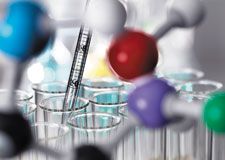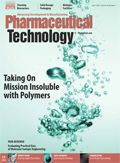Expanding the Chiral Toolbox
Recent chiral advances demonstrate promise for API synthesis.
Andrew Brookes/GETTY IMAGES

The majority of small-molecule drugs in development today contain chiral centers, and according to Global Industry Analysts (GIA) nearly 95% of drugs will be chiral by 2020 (1). GIA estimates that the global chiral technology market, which is dominated by pharmaceutical applications (followed by agrochemicals and flavors and fragrances), will reach $5.1 billion by 2017.
Because FDA requires manufacturers to investigate the properties (physicochemical, pharmacokinetic, etc.) of all enantiomers/diastereomers of chiral drugs to determine their individual safety and efficacy, the development of efficient chiral synthesis technologies remains a primary target for many academic and industrial researchers. Several transformations with significant potential for use in API manufacture have been published in the past year. A few of them are highlighted in the following.
Direct and selective cross-coupling
Researchers in the Doyle lab at Princeton University in New Jersey have developed a direct cross-coupling reaction to produce 1,2-dihydropyridines, versatile building blocks that are highly useful for API synthesis (2). The reaction involves the enantioselective Ni-catalyzed cross coupling of arylzinc reagents with pyridinium ions formed in situ from pyridine and a chloroformate.
The use of pyridine is of particular interest, according to Abigail Doyle, an associate professor of chemistry at Princeton and corresponding author of the article. “A highlight of the method is being able to use pyridine as a substrate because it’s inexpensive and abundant and has rarely been used in transition metal and asymmetric catalysis,” she said (3). Pyridine typically binds to nickel catalysts, inhibiting further catalytic activity. This issue was avoided by adding a slight excess of iso-butylchloroformate, an activating agent that reacts with pyridine to form an intermediate species that does not bind to the catalyst.
The generated, enantioenriched 2-aryl-1,2-dihydropyridine products can be elaborated to numerous piperidine derivatives with little or no loss in enantiomeric excess. Nine different elaborations commonly used by medicinal chemists for drug development were performed to demonstrate their utility (3).
Radical strategy for enantioselective carbon-carbon bond formation
Most enantioselective reactions proceed via polar reactivity, with few radical reactions providing high selectivities. Radical mechanisms are attractive for forming quaternary carbon centers, however, because radical intermediates are not significantly affected by steric factors, as is the case with cationic and anionic intermediates. Researchers at the Institute of Chemical Research of Catalonia (ICIQ) in Spain have recently reported a method that harnesses the potential of radicals for enantioselective synthesis of quaternary carbon stereocenters (4). Paolo Melchiorre and his group at ICIQ used a combination of photoredox and asymmetric organocatalysis to mediate enantioselective radical conjugate additions to β,β-disubstituted cyclic enones.
A chiral organocatalyst containing a redox-active carbazole moiety was designed to generate iminium ions that are then stereoselectively trapped via an electron-relay mechanism by photochemically generated carbon-centered radicals. The reaction proceeds under mild reaction conditions with high enantioselectivity and without the need for transition-metal catalysts, making it a sustainable process (5). “Combining the potential of metal-free enantioselective organocatalysis and visible light photocatalysis can significantly advance the development of a more responsible and sustainable stereoselective chemistry while strengthening the chemistry toolbox to better face the challenges of modern organic chemistry,” noted Melchiorre. He added that “This catalyst may provide further opportunities to stereoselectively generate quaternary stereocenters that cannot be forged by using traditional polar reactivity.”
Non-C2-symmetrical, atropoisomeric functionalized biaryls
Organocatalysis was also employed by scientists at Rice University in Texas to achieve the direct arylation of aromatic C(sp2)-H bonds in phenols and naphthols for the preparation of 1,1ʹ-linked functionalized biaryls (6). Not only have the non-C2-symmetrical, atropoisomeric products not been previously synthesized, they are formed with complete regioselectivity, and the reaction is readily scalable and does not require an external oxidant. Results of density-functional theory calculations suggest that the reactions proceed via an asynchronous [3,3]-sigmatropic rearrangement of an in-situ-formed acetal intermediate.
The biaryls are synthesized from readily available compounds, including quinone monoacetals and phenols/ naphthols. “Using these building blocks, we made 41 different chiral biaryl compounds in a relatively short time,” said corresponding author László Kürti (7). He added that the functionalized chiral biaryls are really versatile compounds. “You can use them outright as organocatalysts or complex them with transition metals to make new transition-metal catalysts. So the possibilities are unlimited. Moreover, these compounds can be used as building blocks en route to natural products with biaryl substructures in them.”
Two enantiomers with one catalyst
Researchers at the University of Sydney in Australia have focused on the development of switchable phosphine ligands for transition metals whose chirality is modulated through an external trigger signal. These molecular motors make it possible to change the enantioselectivity in a catalytic process without the need to synthesize new catalysts. In the report, a photoswitchable chiral bisphosphine was prepared based on a unidirectional light-driven molecular motor that can be used to invert the stereoselectivity of a palladium-catalyzed desymmetrization reaction (8). As a result, each enantiomer can be formed using just one ligand.
The bisphosphine ligand undergoes photochemical and thermal isomerization during unidirectional rotation around the motor central double bond, allowing for control of both the helicity of the ligand and the distance between the two phosphines. Notably, light-induced isomerizations in the ligand are endothermic, while heat-induced isomerizations are exothermic (9). The researchers report obtaining a nearly racemic mixture to very high enantiomeric ratios for each isomer (93:7 and 6:94) for the Pd-catalyzed desymmetrization reaction (8).
Understanding how chiral molecules behave
Scientists at Newcastle University in England and the Swiss Federal Laboratories for Materials Science and Technology are learning about mechanisms of chirality through investigation of biomineralization, a process by which inorganic materials are formed with chiral structures following contact with proteins and polysaccharides, which act as modifiers during nucleation and crystal growth (10). The chirality of the biomolecules is transferred to the mineral structure; understanding how this process occurs can provide insights into the design of organic chiral transformations.
In this report, Werner Hofer and his colleagues used scanning tunneling microscopy, photoelectron diffraction, and density functional theory to investigate how the chiral compound ‘buckybowl’ hemibuckminsterfullerene arranges copper surface atoms. “By understanding this process, we can now force materials to behave in a certain way, using biological plans to create the shapes and structures that we want. This has huge potential in the fields of materials design and drug synthesis,” Hofer said (11). In particular, the knowledge gained could facilitate the development of more efficient and effective enantioselective heterogeneous catalysts.
Now that the proof of concept has been demonstrated, the challenge, according to the researchers, is to identify the right biomolecules that create the specific metal surface morphologies that are suitable for specific catalytic reactions (11).
References
1. Global Industry Analysts, “Global Chiral Technology Market to Reach US$5.1 Billion by 2017, According to New Report by Global Industry Analysts, Inc.,” Press Release, April 4, 2012.
2. J.P. Lutz, et al., Chem. Sci. (2016). Advance article. DOI: 10.1039/C6SC00702C.
3. Princeton University, “New Reaction Turns Feedstock Chemical Into Versatile, ChiraBuilding Block,” Press Release (Princeton, NJ, March 23, 2016).
4. J.J. Murphy, et al., Nature, 532 (7598), 218-222 (2016). DOI:10.1038/nature17438.
5. Institute of Chemical Research of Catalonia, “Radical Route For The Synthesis Of Chiral Molecules,” Press Release (Tarragona, Spain, April 14, 2016).
6. H. Gao, et al., Angewandte Chemie International Edition, 55 (2), 566-571 (2016).
7. Rice University, “Chemical Design Made Easier,” Press Release (Houston, TX, Nov. 24, 2015).
8. D. Zhao et al., Nature Comm., 6, 6652 (2015).
9. The University of Sydney, “Molecular Motors For Chiral Catalysis,” Press Release (Sydney, Australia, October 2015).
10. W. Xiao et al., Nature Chemistry, 8, 326-330 (2016).
11. Newcastle University, “Nature’s Mirror-the Code for Chirality,” Press Release, (Newcastle upon Tyne, England, Feb. 8, 2016).
Article Details
Pharmaceutical Technology
Vol. 40, No. 7
Pages: 28–29
Citation:
When referring to this article, please cite as C. Challener, "Expanding the Chiral Toolbox," Pharmaceutical Technology 40 (7) 2016.

Drug Solutions Podcast: A Closer Look at mRNA in Oncology and Vaccines
April 30th 2024In this episode fo the Drug Solutions Podcast, etherna’s vice-president of Technology and Innovation, Stefaan De Koker, discusses the merits and challenges of using mRNA as the foundation for therapeutics in oncology as well as for vaccines.
Drug Solutions Podcast: Applying Appropriate Analytics to Drug Development
March 26th 2024In this episode of the Drug Solutions Podcast, Jan Bekker, Vice President of Business Development, Commercial and Technical Operations at BioCina, discusses the latest analytical tools and their applications in the drug development market.
INTERPHEX 2025: Use of Walk-In Chambers for Bio/Pharma Development and Manufacturing
April 2nd 2025Sitting down with the PharmTech Group at INTERPHEX 2025, Christopher Murphy, director of Global Business Development and Service Customer Support at Environmental Specialties, discusses the design and critical role of walk-in chambers in the bio/pharmaceutical industry.